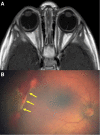A Primary Gastrointestinal Presentation and Novel Genetic Variant of Dyskeratosis Congenita in a Pediatric Patient
- PMID: 37168640
- PMCID: PMC10158458
- DOI: 10.1097/PG9.0000000000000242
A Primary Gastrointestinal Presentation and Novel Genetic Variant of Dyskeratosis Congenita in a Pediatric Patient
Abstract
Dyskeratosis congenita (DC) is a rare telomerase disorder affecting high turnover cells. Malfunction of protective proteins in DC results in patient genomes with shortened germline telomeres leading to genetic instability, cellular apoptosis, and overall cellular lifespan degradation. Classically, reports of DC described a triad of dysplastic nails, reticular skin pigmentation, and oral leukoplakia. However, more recent reports have focused on disease presentation affecting other high turnover organ systems including the gastrointestinal system. Patients may present with dysphagia because of esophageal stricture/web, diarrhea secondary to enteropathy or enterocolitis. We present a pediatric patient who presented with feeding difficulty secondary to an esophageal stricture as the primary manifestation of DC. She was diagnosed with Revesz Syndrome, a rare subtype of DC, along with a novel genetic variant not previously reported. This report serves to bring awareness to gastroenterologists that DC, though classically thought to present with dermatological findings, can present with primary gastrointestinal manifestations.
Copyright © 2022 The Author(s). Published by Wolters Kluwer Health, Inc. on behalf of the European Society for Pediatric Gastroenterology, Hepatology, and Nutrition and the North American Society for Pediatric Gastroenterology, Hepatology, and Nutrition.
Conflict of interest statement
The authors report no funding and conflicts of interest.
Figures
References
-
- Savage SA. Dyskeratosis Congenita. GeneReviews [Internet]. 2019. Retrieved December 29, 2021, from https://www.ncbi.nlm.nih.gov/books/NBK22301/
-
- Arca E, Tüzün A, Tastan HB, et al. . Dyskeratosis congenita with esophageal and anal stricture. Int J Dermatol. 2003;42:555–557. - PubMed
-
- Brown KE, Kelly TE, Myers BM. Gastrointestinal involvement in a woman with dyskeratosis congenita. Dig Dis Sci. 1993;38:181–184. - PubMed
Publication types
LinkOut - more resources
Full Text Sources



